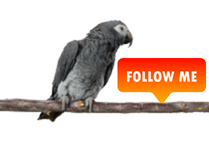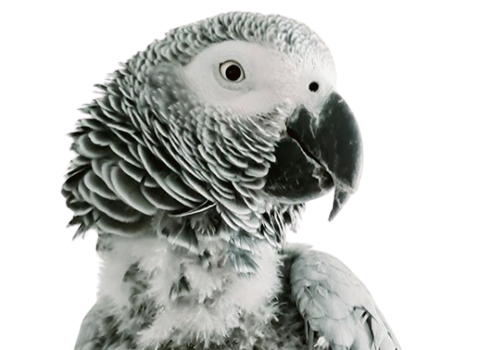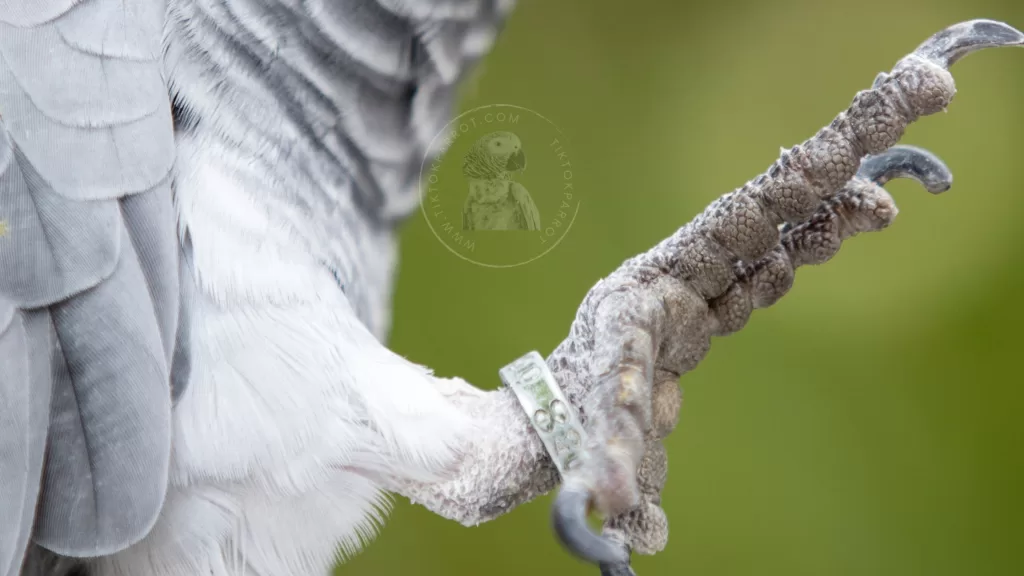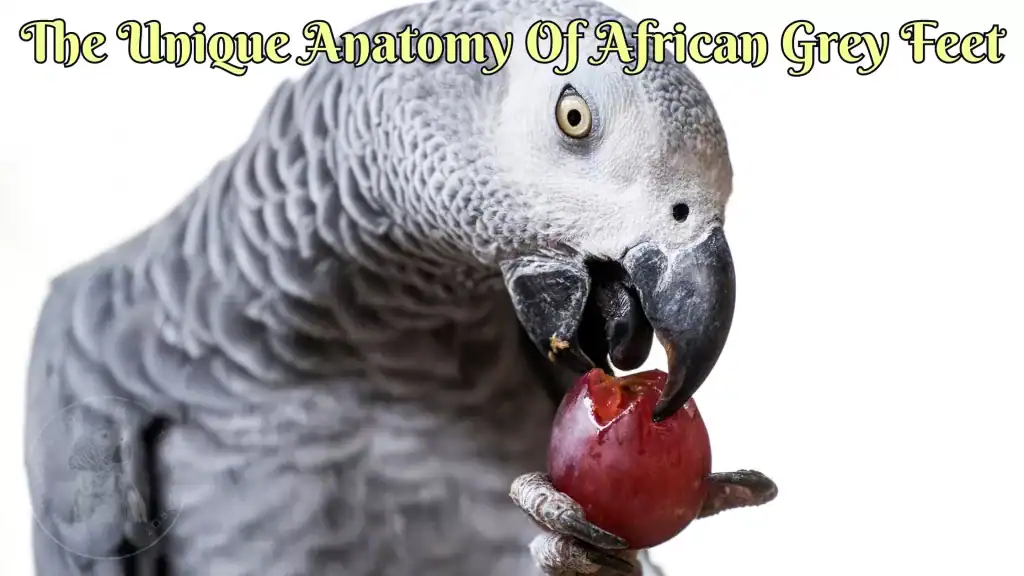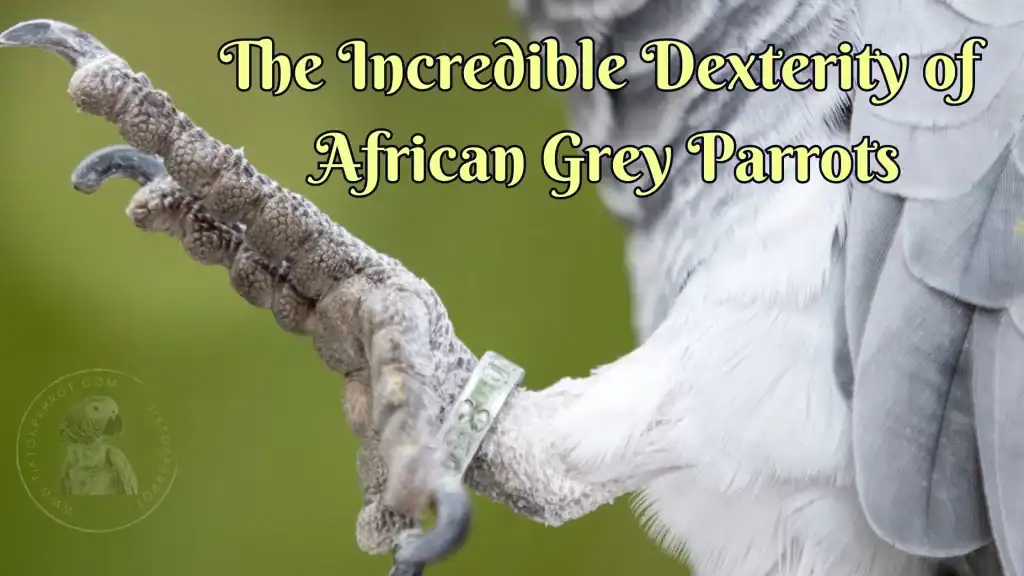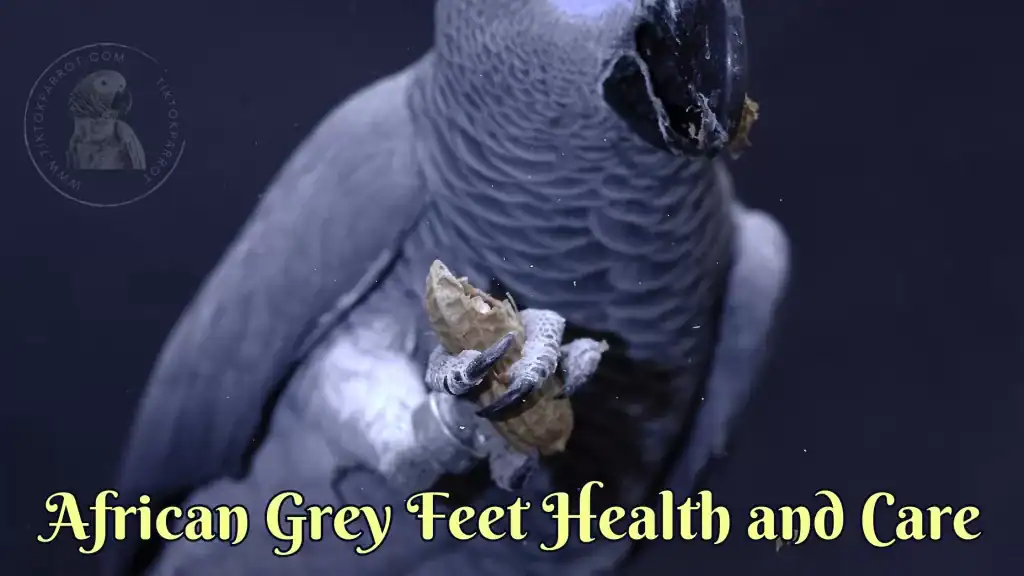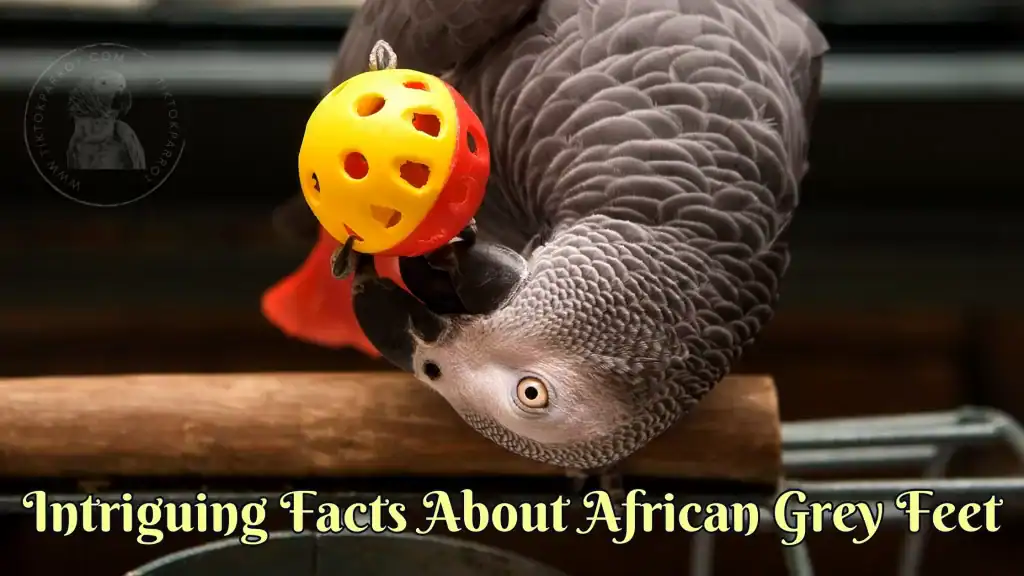The African grey parrot, one of the most intelligent and fascinating species of parrots, has captivated bird enthusiasts worldwide. One of the lesser-known aspects of these amazing creatures is their feet.
This article takes a deep dive into the intriguing world of African grey parrot anatomy, specifically focusing on their feet. Read on to discover the unique adaptations and functions of their feet, and learn how to keep them healthy and happy.
Discover the amazing world of African grey parrot feet, including their unique anatomy, dexterity, and care requirements. Uncover fascinating facts and learn how to keep your parrot’s feet healthy and delighted.
The Unique Anatomy of African Grey Feet
Step into the captivating world of African grey parrot feet and uncover the secrets of their unique anatomy!
With their extraordinary zygodactyl foot structure, these intelligent birds exhibit incredible dexterity and climbing prowess, rivaling even the nimblest of primates. Get ready to be amazed as we explore the fascinating characteristics of African grey feet and reveal the astounding abilities they possess!
African grey parrots, known for their remarkable intelligence and stunning beauty, have always captured the hearts of bird enthusiasts. But have you ever taken a moment to appreciate their unique anatomy, particularly their feet?
African grey feet are truly fascinating, playing a vital role in their survival and day-to-day activities. In this blog post, first we will delve into the captivating world of African grey feet, exploring the intricate details of their anatomy and functionality.
Zygodactyl Foot Structure
African greys, like other parrot species, possess zygodactyl feet. This means they have two toes pointing forward and two pointing backward, providing exceptional grip and dexterity. This arrangement allows them to have a strong and stable grip on branches and other surfaces, enabling them to move with ease through their natural habitats.
Adaptations for Climbing and Grasping
These parrots are known for their exceptional climbing and grasping abilities. Their feet are equipped with sharp claws that help them maintain a firm grip while moving around. Their strong leg muscles provide the necessary force to support their body weight and help them maneuver effortlessly.
Their feet are incredibly strong, thanks to their robust muscles and tendons. This exceptional grip strength enables them to cling onto branches and perch with ease, even in the face of strong winds or aggressive movements. Additionally, their powerful feet are crucial for maintaining balance while in flight or during feeding.
Their dexterity allows them to use their feet like hands, grasping items such as food, toys, or nesting materials with precision. African greys are also known to use their feet for preening, grooming their feathers to maintain their overall health and appearance.
The Role of Scales and Claws
The unique anatomy of African grey feet includes protective scales that cover the top and bottom surfaces. These scales, composed of keratin, provide a layer of protection against injury and abrasion. Their claws, also made of keratin, play a crucial role in their gripping abilities. Greys have sharp, curved claws that help them latch onto branches, grip food, and even defend themselves against predators.
The Incredible Dexterity of African Grey Parrots
Prepare to be astonished by the extraordinary dexterity of African Grey Parrots!
These remarkable birds demonstrate unparalleled agility and precision, using their feet much like human hands.
These parrots are also famous for their incredible dexterity, which allows them to manipulate objects with precision and finesse. In this section, we will explore the amazing abilities of African grey parrots and how they use their dexterity to survive and thrive in the wild.
From adeptly manipulating objects to solving complex puzzles, the versatile feet of African greys highlight their remarkable intelligence and adaptability. Join us as we delve into the captivating world of these avian wonders and uncover the secrets behind their incredible dexterity!
These parrots have a unique ability to mimic and learn human speech, which has made them popular pets and performers in circuses and zoos. However, their dexterity is equally impressive and has been the focus of many scientific studies.
Anatomy of Dexterity
African grey parrots have several physical adaptations that enable their incredible dexterity. Firstly, they have a strong and flexible tongue that they use to manipulate objects and food. They also have a specialized beak that is shaped like a pair of pliers, which allows them to grasp and manipulate objects with precision.
Additionally, they have four toes on each foot, with two pointing forwards and two pointing backwards. This arrangement enables them to perch on branches and manipulate objects with their feet.
The Use of Dexterity in the Wild
These parrots use their dexterity to forage for food and build their nests. In the wild, they feed on a variety of fruits, nuts, and seeds, which they crack open with their beaks and manipulate with their tongues and feet.
They also use their dexterity to construct their nests, which are made from twigs and branches that they weave together with their beaks and feet. This process requires a high level of precision and coordination, which demonstrates their remarkable dexterity.
Social and Cognitive Behaviors
No doubt that grey parrots are highly social and have complex cognitive behaviors. They use their dexterity to communicate with each other, often engaging in play behavior that involves manipulating objects with their beaks and feet.
They also use their dexterity to groom each other, with one bird using its beak to preen the feathers of another. This behavior reinforces social bonds and demonstrates their incredible dexterity.
Domestication and Training
As I mentioned above grey parrots are highly sought after as pets due to their intelligence, personality, and ability to mimic human speech. However, the domestication and training of these birds requires a high level of skill and knowledge.
The process of training a parrot to perform tricks or mimic speech requires patience, consistency, and positive reinforcement. Additionally, the training process often involves the use of objects that the parrot can manipulate, such as puzzle toys or treat dispensers, which utilize their dexterity.
Using Feet as Hands
One of the most remarkable aspects of African Grey Parrot feet is their dexterity. They use their feet much like humans use their hands. They can pick up and manipulate objects, such as food, toys, or even tools, with incredible precision.
Manipulating Objects & Problem Solving
African Grey Parrots are known for their intelligence and problem-solving abilities, and their feet play a crucial role in this. They can hold objects with their feet while using their beaks to manipulate them. This extraordinary ability allows them to solve complex problems and showcase their cognitive skills.
So, we can say African greys are remarkable birds that possess incredible dexterity. Their physical adaptations, social and cognitive behaviors, and domestication have all contributed to their reputation as one of the most intelligent and fascinating bird species.
By studying and appreciating their dexterity, we can gain a greater understanding of their ecology, behavior, and evolution.
African Grey Feet Health and Care
As a responsible owner, you should be aware of the importance of maintaining your African Grey’s feet health. In this section, we will delve into the world of African Grey feet health and care, discussing common issues, preventive measures, treatments, and tips for maintaining healthy feet.
Identifying Common Issues
African Grey Parrots can suffer from various foot health issues, such as bumblefoot, overgrown nails, and dry or cracked skin. It’s essential to monitor your parrot’s feet regularly and address any concerns promptly.
By identifying common issues, taking preventive measures, treating any problems that arise, and following our tips for maintaining healthy feet, you can ensure your parrot leads a happy, healthy life.
Common Foot Health Issues
Just like humans, African greys can experience a variety of foot issues. Being able to identify these problems is crucial for your parrot’s overall health. Below we will discuss some of the common African grey’s foot health issues:-
Swelling
Swollen feet can be caused by infection, injury, or a lack of exercise. If you notice your African Grey’s feet are swollen, it’s essential to consult your avian veterinarian. They can prescribe appropriate treatments such as anti-inflammatory medication or antibiotics to address the issue.
Redness
Redness is another sign of infection or injury. Keep a close eye on your parrot’s feet for any signs of redness, as it may indicate an underlying issue.
Scaly Appearance
African Greys may develop a scaly appearance on their feet due to a fungal infection or mite infestation. Early detection and treatment are key to resolving these problems.
Overgrown Nails
Your African Grey’s nails should be kept at an appropriate length to avoid injury or discomfort. Overgrown nails can lead to issues with perching and walking.
Preventive Measures
Taking preventive measures is essential for keeping your African Grey’s feet healthy.
Regular Inspection
Inspect your parrot’s feet frequently for any signs of injury, infection, or other issues. Catching problems early can help prevent more severe issues down the line.
Proper Perches
Providing your African Grey with a variety of perches of different shapes, sizes, and materials can help prevent foot issues. This allows your parrot to change its grip and exercise its feet.
Nutrition
A balanced diet is crucial for overall health, including foot health. Make sure your African Grey is receiving the necessary nutrients to maintain healthy feet.
Exercise
African Greys need regular exercise to maintain good health, including foot health. Encourage your parrot to move around its enclosure and explore its environment.
Veterinary Care
Regular check-ups with an avian veterinarian can help catch potential issues before they become significant problems.
Treating Feet Issues
If your African grey does develop a foot issue, it’s important to take appropriate action.
Infections
Fungal or bacterial infections require prompt attention from a veterinarian. They will likely prescribe antifungal or antibacterial medication to treat the infection effectively.
Scaly Feet
If your African Grey has scaly feet, consult your avian veterinarian for proper diagnosis and treatment. They may recommend medications or ointments to address mite infestations or fungal infections.
Overgrown Nails
Overgrown nails can be managed by trimming them carefully with the guidance of a veterinarian or an experienced bird groomer. It’s essential to avoid cutting the quick, as this can cause pain and bleeding.
Tips for a Healthy African Grey’s Feet
To ensure your African Grey has healthy feet, follow these tips:
Provide a Clean Environment
Keeping your parrot’s environment clean and free from debris is crucial in preventing foot issues. Regularly clean and sanitize your bird’s enclosure, perches, and toys.
Offer Mental Stimulation
Boredom can lead to over-grooming and foot issues. Providing your grey with toys and activities can help keep them mentally stimulated and less prone to developing foot problems.
Ensure Proper Hydration
Hydration is essential for overall health, including foot health. Make sure your African Grey always has access to fresh, clean water.
Conclusion
African grey feet health and care are essential aspects of parrot ownership. By identifying common issues, taking preventive measures, treating any problems that arise, and following our tips for maintaining healthy feet, you can ensure your African Grey leads a happy, healthy life.
Keeping Your African Grey’s Feet Healthy
Proper care and maintenance are vital for keeping your African Grey’s feet healthy. Provide a variety of perches with different textures and diameters to encourage foot exercise. Regularly trim their nails and keep their environment clean to prevent infections.
As a pet owner, it is crucial to provide a variety of perches with different textures and diameters to promote proper foot exercise and prevent pressure sores. Regularly inspecting your parrot’s feet for any signs of injury, infection, or overgrown claws is also vital to ensuring their overall health.
Intriguing Facts About African Grey Feet
Welcome to the fascinating world of African Grey parrots, where their intelligence and beauty are rivaled only by their incredible feet!
Did you know these remarkable birds possess dexterous, zygodactyl feet, designed for gripping branches and handling objects with the utmost precision?
Get ready to be amazed as we dive into 30 unique and intriguing facts about African grey feet, revealing just how much there is to discover about these extraordinary creatures. From their powerful grip to their surprising communication skills, these avian marvels will leave you in awe of their unparalleled adaptability and captivating charm.
So, without further ado, let’s embark on an exciting journey into the lesser-known realm of African Grey feet!
- Zygodactyl configuration: African Grey parrots have zygodactyl feet, meaning they have two toes facing forward and two toes facing backward. This unique arrangement allows them to expertly grip branches and handle objects with ease.
- Powerful grip: Their feet are incredibly strong and can exert enough pressure to break open hard nuts and seeds.
- Touch receptors: African Grey feet are equipped with touch receptors that help them to feel their environment and identify objects.
- Independent toe movement: Each of their four toes can move independently, providing them with remarkable dexterity.
- Preening with feet: African Greys use their feet to groom their feathers and maintain their overall hygiene.
- Feet as utensils: These birds use their feet like hands to manipulate objects, such as holding food or toys.
- Climbing ability: African Grey feet are designed to support their body weight when climbing trees, branches, and cage bars.
- Foot tapping: African Greys may tap their feet on surfaces to communicate or show excitement.
- Mimicry with feet: African Greys can learn to mimic certain foot movements or behaviors they observe in other birds or humans.
- Foot strength variation: African Grey’s feet strength varies among individuals, with some being able to exert more force than others.
- Muscular control: These birds have precise muscular control over their feet, allowing them to grip objects firmly or gently as needed.
- Nail growth: African Grey parrots have continuously growing nails that need regular trimming to maintain optimal health.
- Foot color: African Grey feet are typically a dark grey to black color, which helps to camouflage them in their natural environment.
- Sensitive skin: African Grey’s feet have sensitive skin, making them susceptible to injuries and infections if not properly cared for.
- Foot size: The size of an African Grey’s feet is proportionate to its body size, allowing for proper balance and grip.
- Grasping reflex: African Grey parrots have a grasping reflex that allows them to instinctively grip onto surfaces when they feel unsteady.
- Thermoregulation: African Greys use their feet as a means of thermoregulation, dissipating excess heat through their unfeathered limbs.
- Perching preferences: African Greys have preferences for the type of perches they use, opting for branches or perches that best accommodate their zygodactyl feet.
- Foot health indicators: The condition of an African Grey’s feet can provide insight into the bird’s overall health, with abnormalities potentially indicating illness or poor nutrition.
- Playful foot use: African Greys may use their feet during play, such as grabbing or holding toys.
- Sleep posture: African Greys often sleep with one foot tucked up into their feathers, leaving the other foot to maintain balance on their perch.
- Foot-based communication: These parrots can use their feet to communicate, such as tapping on surfaces or waving their foot in the air.
- Foot dexterity in flight: African Greys can use their feet to hold onto objects, even while in flight.
- Foot preference: Some African Greys may exhibit a preference for using one foot over the other, similar to human handedness.
- Foot stretching: African Greys may stretch their feet and toes to maintain flexibility and overall foot health.
- Perch hopping: Using their strong feet, African Greys can hop from one perch to another with ease.
- Tool use: African Grey parrots have been observed using their feet to manipulate tools, such as sticks or leaves, to access food.
- Nest building: African Greys use their feet to help construct nests, gripping and positioning materials as needed.
- Feather holding: African Greys have been known to hold a feather in their foot and use it to scratch hard-to-reach areas on their body, showcasing their problem-solving abilities.
- Environmental adaptations: The feet of African Grey parrots are adapted to their native environment, which consists of dense rainforests and woodland areas, allowing them to grip onto a variety of surfaces and branches with ease.
These unique and intriguing facts about African grey parrot feet highlight the incredible adaptability and intelligence of these remarkable birds. Their zygodactyl feet, strong grip, and dexterous abilities enable them to thrive in their native habitats and captivate bird enthusiasts around the world.
My Final Thoughts
I would say African grey parrots are truly amazing creatures, and their feet are a testament to their intelligence and adaptability. Understanding the unique anatomy, dexterity, and care requirements of their feet can help you better appreciate these fascinating birds and ensure they lead healthy, happy lives.
FAQs (Frequently Asked Questions About African Grey’s Feet)
- What is the zygodactyl foot structure?
The zygodactyl foot structure is a unique arrangement in which a bird has two toes facing forward and two toes facing backward. This configuration provides enhanced grip and stability while climbing and grasping. - How does the zygodactyl structure benefit African Grey Parrots?
The zygodactyl structure benefits African Grey Parrots by allowing them to have a strong and stable grip on branches and other surfaces, enabling them to move with ease through their natural habitats. - Can African Grey Parrots use their feet like hands?
Yes, African Grey Parrots can use their feet much like humans use their hands. They can pick up and manipulate objects with remarkable precision, such as food, toys, or even tools. - How do African Grey Parrots use their feet for problem solving?
African Grey Parrots use their feet for problem solving by holding objects with their feet while using their beaks to manipulate them. This extraordinary ability allows them to solve complex problems and showcase their cognitive skills. - What are some common foot health issues in African Grey Parrots?
Common foot health issues in African Grey Parrots include bumblefoot, overgrown nails, and dry or cracked skin. Regular monitoring and prompt attention to concerns are crucial for maintaining foot health. - How can I keep my African Grey’s feet healthy?
To keep your African Grey’s feet healthy, provide a variety of perches with different textures and diameters to encourage foot exercise. Regularly trim their nails and keep their environment clean to prevent infections. - Are African Grey Parrots “footed,” like humans are handed?
Yes, African Grey Parrots have a unique “footedness,” with some being “left-footed” and others “right-footed,” similar to human handedness. - How do African Grey Parrots use their feet to communicate?
African Grey Parrots use their feet in social interactions, such as foot-tapping, to communicate with other parrots. This behavior can convey messages or express emotions. - Can African Grey Parrots hold objects with their feet?
Yes, African Grey Parrots can hold objects with their feet, using their zygodactyl structure to grip and manipulate items with great precision. - Do all parrots have the same foot structure as African Greys?
Most parrots share the zygodactyl foot structure of African Grey Parrots. However, there may be slight variations in size, shape, and strength among different parrot species. - How do African Grey Parrots use their feet to preen themselves?
African Grey Parrots use their feet to scratch their heads and preen their feathers, helping to maintain their plumage and remove any debris or dead feathers. - How can I tell if my African Grey has a foot health issue?
Signs of foot health issues in African Grey Parrots include limping, swelling, redness, sores, or unusual growths on the feet. Consult a veterinarian if you notice any of these symptoms in your parrot. - How often should I trim my African Grey’s nails?
Trimming frequency may vary depending on individual growth rates, but generally, you should trim your African Grey’s nails every 4 to 6 weeks or as needed. - What types of perches are best for African Grey Parrots?
A variety of perches with different textures and diameters is ideal for African Grey Parrots. Include natural wood, rope, and textured perches in their environment to encourage foot exercise and promote overall foot health. - How can I provide proper foot exercise for my African Grey?
To provide proper foot exercise for your African Grey, offer a variety of perches with different textures and diameters, and incorporate toys or objects that encourage grasping and climbing. Also, consider incorporating play stands or climbing structures in their environment to stimulate movement. - What other bird species have zygodactyl feet?
Besides parrots, some other bird species with zygodactyl feet include woodpeckers, cuckoos, and certain types of owls. This foot structure allows these birds to have enhanced grip and climbing abilities. - How do African Grey Parrots use their feet for climbing?
African Grey Parrots use their zygodactyl feet for climbing by gripping onto branches or other surfaces with their two forward-facing and two backward-facing toes. Their sharp claws and strong leg muscles provide additional support and stability while climbing. - How strong are the leg muscles of African Grey Parrots?
African Grey Parrots have strong leg muscles that enable them to support their body weight and maneuver with ease while climbing and grasping. These muscles help provide the necessary force for gripping and maintaining balance. - Can African Grey Parrots use tools with their feet and beak?
Yes, African Grey Parrots can use tools with their feet and beak. They can hold an object with their feet while using their beak to manipulate it, showcasing their cognitive skills and problem-solving abilities. - How do African Grey Parrots maintain a strong grip with their feet?
African Grey Parrots maintain a strong grip with their feet through their zygodactyl foot structure, sharp claws, and strong leg muscles. These adaptations enable them to have a firm grasp on various surfaces, allowing them to climb and manipulate objects with ease.
If you found this blog helpful, It would be great if you could share it with your family and friends who might find it useful as well.
You might like to read these as well 🙂
The Mesmerizing Eyes of African Grey Parrot & What They Can Tell
The Battle of the Birds: African Grey Parrot vs Macaw
African Grey Parrot Male or Female? (Determine Gender of African Grey)
Is Your African Grey a Jealous Bird? Here’s What You Need to Know!
The Surprising Benefits of Owning an African Grey Parrot
African Grey Parrots: The Ultimate Guide to Care and Training
Unlock the Secrets of Choosing the Perfect African Grey Parrot
The Importance of a Cage for Your African Grey Parrot
Understanding of Grey Parrot’s Body Language
For more useful content about African grey parrots, you can subscribe my site with your email to get notification upon publishing a new blog, the subscribe box you can see on the right side of this page. Also if you get an alert on your web browser while browsing my site, allow it and that will also give you an alert whenever I publish a new blog. 🙂
Stay safe and much love !

